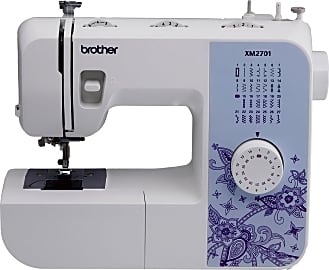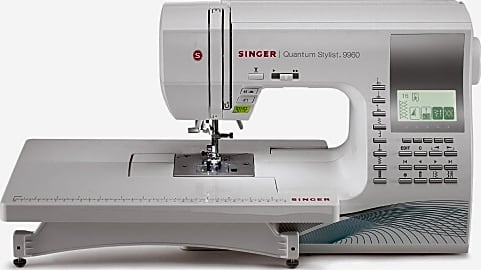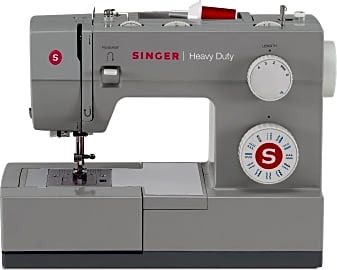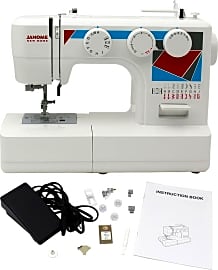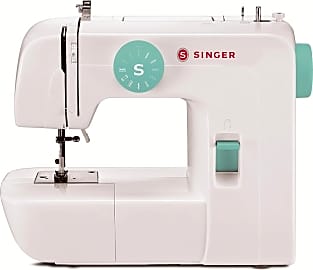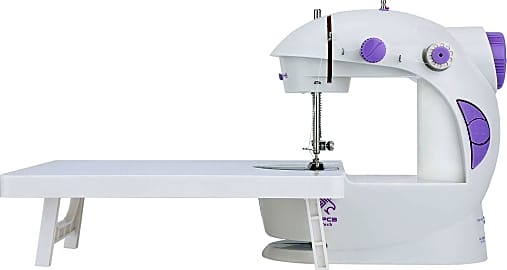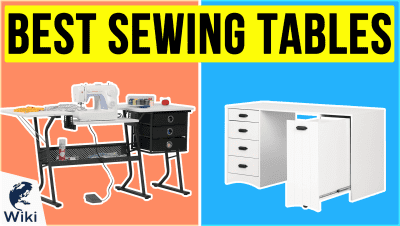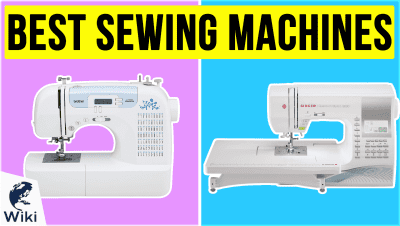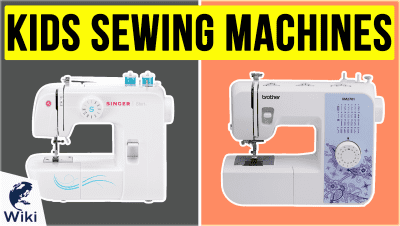The 10 Best Portable Sewing Machines

This wiki has been updated 34 times since it was first published in February of 2018. Any sewing machine that isn’t permanently mounted to a table or cabinet or is lighter and smaller than standard models can be described as "portable." To cover all the bases, we’ve included a wide variety of models on this list, from lightweight mechanical choices to more robust computerized options. They are especially useful to those taking classes outside the home. When users buy our independently chosen editorial picks, we may earn commissions to help fund the Wiki.
Editor's Notes
August 25, 2020:
We still like the Juki TL-2000Qi as a top choice, but we've selected the Brother CS7000i over the CS6000i. The upgraded CS7000i has more built-in stitches, which translates to greater versatility. This versatility is also offered by the CS7000X, but we ultimately opted for the CS7000i because it provides a higher maximum speed than does the CS7000X. There's also the Brother XM2701, a model that is simpler than the aforementioned. It may not be the best option for very advanced sewers, who may need more features to support their creativity, but beginners can count on it for a relatively easy learning experience.
For those with advanced skills, we added the EverSewn Sparrow QE. It's on the pricey side, but for those who need a sturdy, versatile choice with professional features, it's definitely one to consider. It's a touch larger than some portable models, but it's still small enough that you can carry it, and it should feel sturdy on just about any sewing table. The Singer Quantum Stylist 9960 is also robust enough for those who need flexibility, especially since it offers 600 stitches. Its bobbin winding and use are not as smooth as could be hoped for, however, so if you are given to impatience, you might find yourself frustrated.
April 30, 2019:
Thanks to their durability and usability, it remains tough to beat the Juki TL-2000Qi and the Brother CS6000i. Unlike many models marketed for portability, they are plenty versatile, offering a wide range of stitches and practical features that ensure your sewing time is fruitful, not frustrating. The Juki is the more robust and expensive option, making it the better choice for those who already have some experience. We also added the Janome Couture, which is light, simple, and budget-friendly. There's the Janome Mod-19, as well, which is just a touch more complicated. Both have eye-catching styling that most sewers would be proud to display. When it comes to portable models that aren't quite full-featured machines, we like the Msdada Handheld and the Varmax Mini. Note that these are for small projects and repair, so you should not expect to whip up a prom dress or bedspread with them.
Special Honors
Husqvarna Viking H Class 100Q The Husqvarna Viking H Class 100Q weighs in at only 15 pounds, but it's certainly not light on features. It offers everything you could need for a frustration-free experience, including a needle threader, an extra-high presser foot lift, a speed-control slide, and much, much more. husqvarnaviking.com
Sailrite Ultrafeed LSZ-1 Basic The Sailrite Ultrafeed LSZ-1 Basic is perfect for nautical applications, since it is tough enough to tackle sailcloth and heavy canvas, but it's just as handy for home use, especially when it comes to those heavy-duty jobs and fabrics. This is largely thanks to an outsized flywheel that allows for slow speeds and precision. sailrite.com
Bernina 335 Even the most cramped of apartments is no problem when you have the Bernina 335, which offers a diminutive footprint that doesn't demand a large table. Capable of sewing at speeds of up to 900 stitches per minute, it puts 91 decorative stitch options at your fingertips, as well as quick and simple buttonholes. bernina.com
What’s In A Name?
As you might expect, the computerized versions are pricier, but tend to have a wider range of features.
The "portable" in portable sewing machine serves to distinguish these models from their larger or manual counterparts, such as treadle machines that don't lend themselves to travel. But within the group of machines that could be called portable, there are several types available, a choice that largely depends on what you'll be sewing, the features you want, and the amount of money you wish to spend.
On the lower end of the price spectrum, you'll find handheld sewing machines. True to their name, these machines fit in your hand, making them the most portable of the bunch. You won't get varying stitch types with these, and you probably shouldn't expect to be able to create whole garments. Instead, think of these as an on-the-go fix-it helper, good for costume designers or stage moms, for instance.
Slightly more expensive are mini portable machines. These try to do much of what their full-sized counterparts can do, only with a smaller footprint. If you live in a dorm or studio apartment, a mini machine will give you the freedom to fix garments and do some light sewing without giving up too much precious storage space. "Light" is the operative word here, though, as these machines are generally not as robust and probably won't give you the features and durability you need for heavy-duty garment construction and quilting.
On the higher end of the price spectrum are regular full-size portable machines, although these vary so widely in terms of features, durability, and capabilities that there are models to fit all budgets. Because there are so many choices within this category, selecting can feel a little overwhelming, but a good place to start is deciding between a mechanical and a computerized machine.
Here, mechanical doesn't mean manual (as in a stationary treadle machine); rather, a mechanical sewing machine is one that doesn't use an on-board computer for stitch selection and so on. To change stitch types, for instance, you'll have to turn a knob or move a lever. A computerized machine, on the other hand, has a keypad for making selections electronically. As you might expect, the computerized versions are pricier, but tend to have a wider range of features. While neither one is necessarily better, mechanical models are often the choice of budget-conscious beginners and those who would prefer not to deal with computerized technology.
Must-Have Features And Accessories
Once you've decided which type of portable machine you want, you'll need to select one with the right features for the type of projects you'll be making. You should probably also consider those features that will make working with the machine more comfortable for you.
Once you've decided which type of portable machine you want, you'll need to select one with the right features for the type of projects you'll be making.
One of the most critical parts of your sewing machine is the feet. Most models will include at least an all-purpose foot and a buttonhole foot, which are enough for general sewing, from garments and blankets to curtains. More advanced garment makers often rely on zipper, blind hem, and overlock feet, while a quilter will need a high-quality walking foot. If the machine you like doesn't include every foot you need, don't worry, as you can buy feet separately. Before you buy, it's a good idea to check out whether the brand offers a range of feet for purchase and whether the machine is compatible with universal feet.
Another feature you might consider is the number of stitches the machine can make. Some computerized machines today can create literally hundreds of stitches, a feature that is exciting in the buying stage, but often goes underutilized in actual practice. Most beginners are fine with a machine that produces the five to 10 most common stitches.
Then, there are the features that are more about comfort and usability. For some sewers, an automatic needle threader, programmable needle position, and thread cutter are non-negotiable, while for others, these are nice to have, but not critical. Quilters will probably appreciate a knee lift for hands-free presser foot raising, and just about everyone can appreciate a strong light (although a desk lamp will do in a pinch). As for the bobbin, beginners are almost always well-served by the ease of use a top-load, drop-in bobbin offers, and in fact, many portable sewing machines in the low-to-medium price range are of this type.
A Brief History Of The Portable Sewing Machine
The sewing machines we use today have a long, somewhat murky lineage that's fraught with intrigue, patent wars, and even an uprising or two. After all, garments, whether for royalty or peasants, were hand sewn long before machines were invented; the sewing machine, as crucial as we find it now, was something of a threat to no small number of tailors and seamstresses. This "threat" made its first appearance in 1790, the brainchild of Englishman Thomas Saint, but his model never saw workable success. It wasn't until Barthélemy Thimonnier released his more usable creation in 1829 that the sewing machine started to gain a toehold.
For one thing, home electricity wasn't as common as it is now, and for another, the first versions were quite bulky.
These early machines were powered by crank at first, then by treadle. Singer, a popular machine company even today, introduced the first electric machine in 1889, but it took some time for these models to completely replace the manual-powered versions. For one thing, home electricity wasn't as common as it is now, and for another, the first versions were quite bulky. In fact, their motors were on the outside, only later coming to be housed inside the body's case. Most sources agree that these electric portable versions gained widespread use between 1900 and 1910.
Today, the majority of sewing machines, whether in household or industrial settings, are electric, with most at-home machines designed to move and travel easily. For many sewers, this portability is crucial, as classes and quilting retreats require that participants bring along their machines. Over the years, portable sewing machines have also become smaller, quieter, and easier to use, making them an excellent addition to any home, whether for artistic creation, garment making, or home textile repair.



